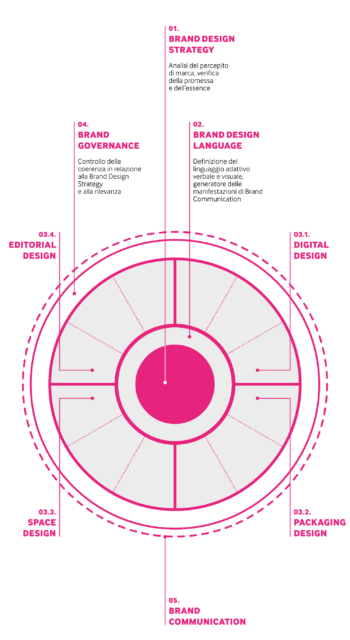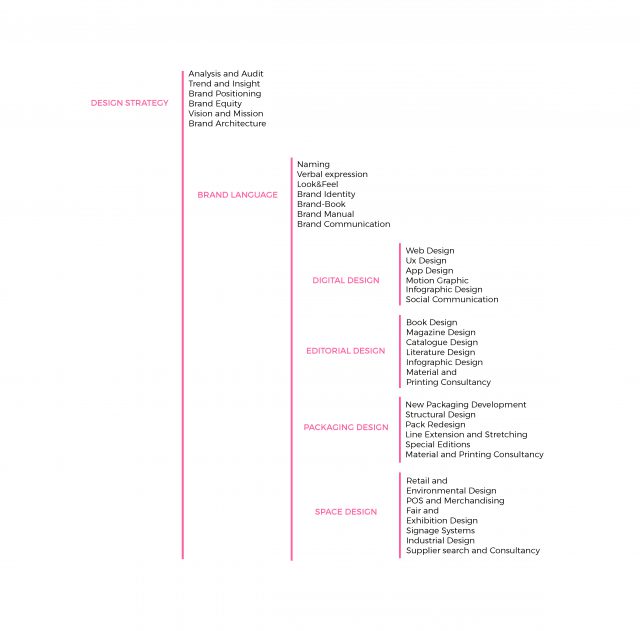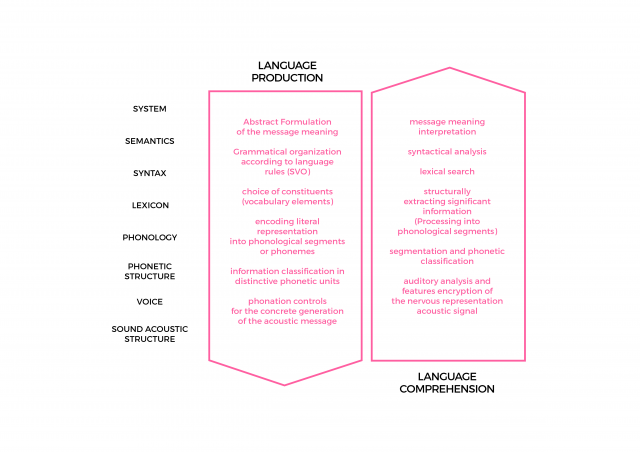Branding Model CEU | 0.9
Branding Design Oriented, published in the first edition in 2009, shows exhaustively the brand model invented by Elio Carmi called “branding model CEU”. The underlying issue that the CEU branding model faced and used as an interpretative and innovative parameter was to define and put in the center of the system– as a tool /device – the “design” as a method ab origine of the brand. In addition, this model shows as an essential element the brand governance, the basis of the activities aimed at the brand building, always having the brand strategy – the brand design strategy – as the reference matrix. Everything still answering to the basic questions to which the so called “state” models tend, or what is a brand, and/or “management” models, or how a brand works, but defining an operational, planning and practical mode.
The brand is therefore seen in a single multi-componential system, in which the single elements are interrelated and constantly interact with each other, in an exchange relationship.
The brand is therefore seen in a single multi-componential system, in which the single elements are interrelated and constantly interact with each other, in an exchange relationship. This interconnection between the quantitative and qualitative elements is not equal and constant, but it changes and is structured differently depending on the contingencies, the needs, the context, the market etc.
This means that the brand system can and must work not only and not always as a single large body, but as a machine consisting of several parts where even the single components, each single element of the brand, can and must work alone, while keeping its own DNA, its own original principle.
Considering the brand as a multi-componential system means to read, interpret and govern it as a whole of elements coordinated to form a single functional unit. In this way, the brand already contains implicitly the reference to the idea of method, strategic process followed for the organization and the realization of a purpose, a clear goal.
That is to say that all the brand elements should be considered, evaluated, conducted and governed by a single vision and must work through a single scheme of values; the values of the brand must always be shared on all levels of management and development/evolution.
To better understand what a multi-componential image is, we can take the portrait metaphor as an example, where the construction of the face, of the drawing representing the person, is the result of the combination of single traits, of brush strokes, which, in turn, compose the drawing of the single parts of the face, for example, the ear, the eye, the nose and so on. But it is the whole, the final result of the image composed of the single traits and the single parts which produces a distinct difference, an unmistakable distinction between the faces of “Les demoiselles d’Avignon” by Pablo Picasso and the face of “La Gioconda” by Leonardo da Vinci, or a self-portrait by Francis Bacon.
The brand puts its place of interest in the area of identity and identification, which makes each subject/object different and unique.
The brand puts its place of interest in the area of identity and identification, which makes each subject/object different and unique. However, we can not always value the diversity over time. Only if the values are understood, maintained and updated, and above all expressed and made perceptible, then the differences and single characteristics of the face can be consolidated, and they can find, through a strategic approach, their own way to exist and to resist over time; where the evolution of the form, – of a face in the illustrated metaphor – though marked by the age and the context, remains recognizable and identifiable, and where the features still denote the person identity in its representation and image and in its coherence to the initial values.
The vision of the brand as a multi-componential system is further explained through an analogy with the process of the understanding and production of the “sense” in communication (whether verbal, visual, auditory, tactile, olfactory, gustatory, material, etc.). Because it is in the process of understanding, production and management, or the conscious and constant control of meaning in communication, semiotics, cognitive science and, more generally, cognitive linguistics, that it is fundamental to always look at the two constituent parts of the speech, or rather its normative and semantic component.
The normative component is the whole set of grammatical, syntactic, prosodic rules, and anything else: the code shared by a speech community (the quantitative, commensurable and computable element). The semantic component is the plan of communication values (the qualitative element), it regards its contents, in terms of concepts, ideas, abstractions and “deeper meanings”, of which the normative component represents, so to speak, the dress, the outward, material and tangible form with which the contents are dressed. The normative component and the semantic component, together in a web of interrelationships that run around the process of communication, build the meaning of the message, they are the bearers of “sense”.
The interaction between the two components of the communication structure is appropriate for the concept of brand governance of Carmi e Ubertis. On one hand, in fact, the brand governance is a strategic brand management process that unfolds in distinct phases (the various types of intervention and management on the brand). On the other hand, it is made up of multiple levels (Brand Design Strategy, Brand Language, Digital Design, Packaging Design, Space Design, Editorial Design), all interconnected to each other– everyone with its precise purposes, or all, or a combination of some – contribute to the construction and control of the brand “sense”. In order to deeply analyze even only one of the mechanisms that make possible the strategic management of the brand, it is essential to examine it in its different “interfaces”, always referring to the cross constant, that is the need to produce “sense”.
This model has also the aim to emphasize the need for a brand governance, considered as a system consisting of interfaces, complementary and at the same time modulated, depending on the needs. The entire model is characterized by the presence of differentiable and variable parameters, which, taken individually or in combination, are always and transversely a reference to a single fixed parameter, or to the production of the brand “sense”, which here is intended as a qualitative parameter and the backbone of the entire project of strategic brand management (Brand Design Strategy). The fundamental objective is, in fact, to introduce a model for brand management – branding – that combines the quantitative dimension, the economic paradigm, represented especially by strategic and operational marketing concepts, with the qualitative dimension, or the culture of the project coming from the design world, which over time has consolidated its structuring position in relation to projects and every brand manifestation.
This model, called “branding model: CEU | 0.9”, is the result of a concrete work on the brand, performed and improved over the years, as a necessary support for communication projects, covering different areas of strategic design intended as a mediator/bearer of meanings, or media-design.
Doing Branding Design Oriented.
The “design” term is understood in its original meaning of “project”, or thought bearer of sense, which is concretized and manifested in the drawing and in its shape construction (not formalism), as one of the functions of the same. Therefore, in this context, the design is the place where, in accordance with the ergonomic functions, production, use and ultimately aesthetic function, it defines the process leading first to the prototype, and then to the product, aimed at its serial multiplication and that is the natural bearer and interpretation of “sense” and consequently of communication.
All creative, professionals, entrepreneurs, often called genes, but whose genius is rooted in a global and strategic vision, designed in a rigorous and scientific, but always governed according to a well-defined and objective address.
Therefore it is a model that has the ambition to have already been innovative (at its birth in 2009), valuing and giving importance to the strategic component of the brand management, referring back to a theoretical and intellectual approach that had its greatest creative interpreters in figures such as Paul Rand, Raymond Loewy, Walter Landor, Herb Lubalin, Milton Glaser, Dieter Rams. And to get to the present day, in creative and entrepreneurial personalities such as Walt Disney, Steve Jobs, Luciano Benetton, Lorenzo Fluxà, Giorgio Armani, Lino Dainese. All creative artists, professionals, entrepreneurs, often called geniuses, but whose genius is rooted in a global and strategic vision, designed in a rigorous and scientific way, but always governed according to a well-defined address and objective.
In today’s globalized and cosmopolitan world, more and more influenced by competition and the continuous development of new communication media, the companies, institutions, governments, cities, products, increasingly feel the need to define and communicate distinctly their identity, in order to differentiate themselves from competitors and make their diversity immediate and visible.
In fact, although it can be said that the identity of any object is its inherent being, its essence as such is stable and unchanging over time, it is necessary to take into account the variable with which this “object” must always relate and with whom it constantly must stand face to face: the context in its condition of time and space. The context is a variable datum, it changes, it is characterized by a dynamism that changes increasingly. Therefore, due to the close link that relates the object to the context and therefore also to the market, the brand can not be static and unchanging, because the structure of the global environment changes and the individual segments that compose it are constantly moving. This means that the coordinated projects that supply the brand must be able to grow and evolve, follow the changes of the time and constantly update. The brand must therefore consider the importance of the relationship between its founding values and its ability to adapt to changes in the external environment. In addition, it must also necessarily take into account the definition of the target, the recipients to whom it is addressed. Therefore it becomes important to identify the touchpoints (points of contact), the channels and the most appropriate means of communication, which can range from the shape of the product to the packaging, from the exhibition spaces to engagement activities, from social networks to pro bono activities, etc.
The CeU | 0.9 model
Before illustrating the “CEU | 0.9 branding model” we should highlight one aspect of the brand the existing brand models often tend to underestimate or take for granted. Many brand models seem to assert that brands characterized by different dimensions and purposes depend on the same operating logic. This can not be true, in fact each brand has several target audiences and therefore it is expected to develop different strategies from time to time to achieve them. The brand portfolio breadth and the territory it occupies necessarily affect the strategy that the brand will develop, both to acquire a distinctive identity with respect to that of its competitors and to communicate as effectively as possible to the target audience.
To different strategies correspond also different tools and different project areas in which the brand will choose to invest. The strategy is therefore always central, and this brand management model leverages the importance and the centrality of the strategic vision. Doing branding, according to this interpretative model, first of all means to recognize that each area of intervention, though provided with its specific features, works only if it is thought of as a piece of a larger mosaic, ruled by the Design Strategy
Secondly, the model highlights the dynamic interaction between the intangible and the tangible aspects of the brand.
Secondly, the model highlights the dynamic interaction between the intangible and the tangible aspects of the brand. In such model, this function is performed by the Brand Design Strategy, whose mission is to identify and coordinate the immaterial dimension of the brand by monitoring and ruling at the same time the way through which it is made tangible and perceptible to consumers, people and users.
Following a centrifugal logic having the Design Brand Strategy as its center, the specialized project areas, which are used depending on the type of intervention, build brand manifestations. They respond at the same time to a centripetal logic that has the brand design strategy as a reference. This logic finds its catalyst in the brand management strategy, that is, in branding.
The Brand Design Strategy, in the economy of the centrifugal and centripetal logic that characterizes the CEU model, is the place and the moment in which, always and for each specialized area, the “direction”, the governance, the guardianship of the brand are arranged and the brand future is defined in its essence.
The model we suggest here as revisited in 2020 keeps the initial concept of 2009 as its original matrix, but it changes its structure in relation to the increasing attention that is given to the design as a key, operational and interpretative tool for the management of complex systems and in our case as a central part of the branding process.
With this in mind, the new model used to optimize the brand guide / governance function, has introduced an external area around the central area of the brand design strategy, which indicates the need to define the system language intended as an Alphabet, the set of the initial signs, which will make the manifestations able to be related to the strategy and identified with immediacy; this is in fact the first material dimension of brand manifestation; or better, what characterizes the brand identity, the warning sign of any further design activity. This is the first concrete step from the concept to the project, and it is the synthesis of the acquired definition of design as a result of form and function, that is, of aesthetics and value content. The rules that here are adaptive will then define the verbal and visual expression of the brand design strategy. Longer the pre-defined language will be organic, recognizable and flexible, greater resilience will have the brand.
In ceu | 0.9 model, the specialized areas of the project are updated in the definitions and partly in the enumerations of contents – digital design, packaging design, space design, editorial design and the Brand Communication area – ie the places where you give concrete and material shape to the symbolic, emotional, experiential and rational contents, expressed by the brand, contributing at the same time, through this process, to their redefinition and re-hierarchization.
The project areas of the CeU/0.9 branding model
The diagram shows the different branding project areas and should therefore be interpreted as a modeling of what is happening in the strategic understanding phase, placed in the center


